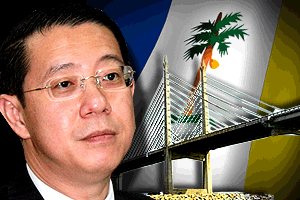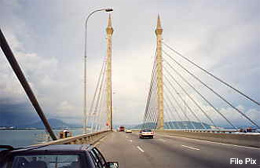Chief Minister Lim Guan Eng has called for the abolition of toll rates on the Penang bridge which marks the 25th anniversary of its opening today.
"At present, 1
 00,000 vehicles cross the bridge daily. Whether it is in building or management fees, the toll company has made a profit. (So) I hope the toll can be abolished,” he told a press conference at his office today.
00,000 vehicles cross the bridge daily. Whether it is in building or management fees, the toll company has made a profit. (So) I hope the toll can be abolished,” he told a press conference at his office today.
In June, Guan Eng had called for the toll rates to be slashed , claiming that the operator had covered its costs.
The toll rates vary between RM1.40 (for motorcycles) and RM75 (for large lorries) at the Sebarang Jaya toll booth. Saloon car owners pay RM7.
The bridge connecting the island to the mainland was completed on April 13, 1985, and opened to traffic on Sept 14 that year. At the time, it was the world’s third-longest bridge at a length of 13.5km.
Guan Eng also acknowledged the contribution of second chief minister Lim Chong Eu for recognising the dire need for a transport system that would link both sides of Penang seamlessly.
The bridge took 3.5 years to build, with as many as 2,000 workers employed at the peak of its construction.
 “Nine workers lost their lives during construction. Their hard work and sacrifice should always be remembered,” said Guan Eng.
“Nine workers lost their lives during construction. Their hard work and sacrifice should always be remembered,” said Guan Eng.
Lim also honoured the contributions of industry professionals involved in the project, especially locals like Chin Fung Kee and Liaw Yew Peng.
“The construction cost was initially budgeted at RM850 million, but the final cost was RM100 million less,” he said.
"Professor Chin’s various innovative design features, such as the use of rubber pads to take care of the seismic loading, have been widely adopted elsewhere.”
Crisis management plan
However, Guan Eng said there is much room for improved management on the part of the bridge concessionaire.
He was referring to the incident on Sept 11, when three power cables under the bridge caught fire . It caused massive traffic jams stretching several kilometres on both sides of the bridge.
Guan Eng said the fire is a reminder that safety measures on the bridge need a through review and overhaul.
“The lack of coordination between the bridge concessionaire and the ferry operator was also apparent during the fire,” he said.
“There is a need to mitigate traffic congestion when contingencies arise. A functional crisis management and traffic plan must be set out.”

